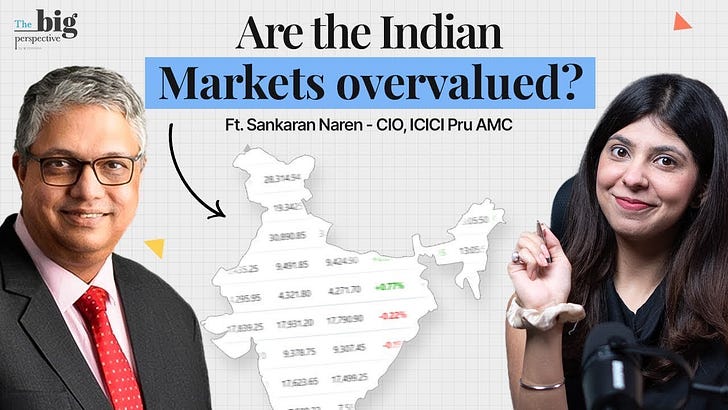Hello readers!
Ever feel like the market's giving you mixed signals? One day the headlines are screaming about all-time highs, and the next, they're warning of impending doom. Well, in this episode of The Big Perspective, I sat down with Sankaran Naren, CIO of ICICI Prudential, for a deep dive into today’s stock market landscape, discussing key market dynamics and the broader economic outlook. Naren’s reputation as a seasoned contrarian investor has made him a respected voice in Indian finance, particularly for his sharp analysis of market cycles. Here’s a blend of takeaways that I found insightful.
You can listen to this episode on Spotify, Apple Podcasts or watch the video here 👇
Current valuations and market risks
Naren’s perspective on current market valuations was straightforward: they’re high. While not necessarily signaling an imminent crash, he suggests that elevated valuations mean returns could be more moderate moving forward. Valuation spikes, especially in smallcaps and midcaps, reflect investor enthusiasm—fueled largely by retail inflows—but they also necessitate caution. He shared a vivid reminder that “for markets to correct, all it takes is a trigger,” whether from within the Indian economy or external factors like a global economic slowdown. His advice? Don’t expect rapid corrections, but prepare for more measured returns and consider diversified asset allocation strategies, such as hybrid funds, to manage risk effectively.
The hype around small-caps and midcaps
The conversation turned to smallcap and midcap stocks, which have seen steep price-to-earnings (P/E) ratios, sometimes as high as 40 times earnings. For Naren, this phenomenon isn’t necessarily sustainable. He pointed out that excessive P/E ratios suggest investors may be paying for expected growth that these companies might struggle to deliver consistently. This scenario, he noted, resembles past market cycles where such high valuations often resulted in extended periods of underperformance relative to the overall market.
Source : Trendlyne
The sectors standing out
Despite the high valuations, Naren identified a few sectors still holding potential. Defense, railways, and select public sector units (PSUs) have seen significant gains, partly due to government spending. However, he advises a discerning eye: while these sectors benefit from policy support, some valuations may already be pricing in most of this advantage, especially given increased interest from retail investors. Interestingly, he sees value in financials and specific banking stocks, which remain reasonably priced and could be resilient in the face of economic fluctuations.
The big picture of the Indian economy
One of Naren’s most optimistic viewpoints centered on the Indian economy itself. With sound macroeconomic fundamentals—such as fiscal prudence, controlled inflation, and a boom in service exports—he described India’s economic story as “a sweet spot” globally. This foundation offers strong long-term prospects, making India an attractive market for investors despite stock market exuberance. According to him, the economic outlook is stable; it’s the over-enthusiasm in the stock markets that warrants caution, not the fundamentals of the economy.
Inflation, Interest rates, and central bank measures
On the topic of inflation and central bank actions, Naren was clear: while high-interest rates have squeezed bond markets in recent years, the worst may be behind us. Although the rate-cutting cycle might start, he warned against expecting drastic cuts. Instead, he highlighted the importance of focusing on long-term stability in bond markets and maintaining a balanced view when assessing future interest rates.
India Repo Rate Graph
What would the capital gains tax change mean for us?
Changes to capital gains tax are unlikely to dampen foreign investor interest in Indian markets significantly, according to Naren. He believes this adjustment might actually support the mutual fund industry by widening the scope of fund offerings and enabling investors to access a more diverse range of options. He recommended that investors remain vigilant about asset allocation and not let tax changes sway them from a well-thought-out investment strategy.
Parting advice for investors
Naren’s final thoughts served as a wise reminder: practice caution, diversify, and avoid over-leveraging. His guidance against becoming a “full-time investor” resonated strongly. He advised keeping a day job and treating investing as a disciplined, part-time endeavor rather than an emotional, all-consuming commitment. “Investing,” he said, “is best done unemotionally and in balance with other sources of income.”
Final thoughts
This conversation with Sankaran Naren was both refreshing and grounding, highlighting the importance of maintaining a balanced perspective in an overheated market. His insights are a powerful reminder that disciplined investing, coupled with a level-headed approach to risk, can pave the way for sustainable wealth creation. In a market filled with hype and rapid price swings, Naren’s advice feels especially pertinent: stay diversified, focus on asset allocation, and remain cautiously optimistic about India’s promising economic landscape.








test
good